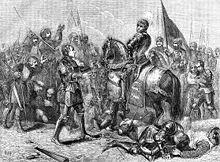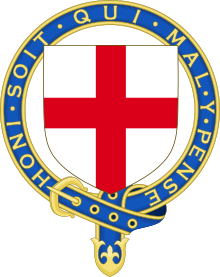John Savage (soldier)
Savage most notably fought at the Battle of Bosworth Field in 1485, where he commanded the left flank of the Tudor (Lancastrian) army to victory and is said to have personally slain the Duke of Norfolk in single combat.Consequently, Savage was one of the prominent figures who invited Henry Tudor to invade England in 1485, a struggle which culminated in the Battle of Bosworth Field.This event was notable enough for Pope Innocent VIII to announce a papal bull which established modifications affecting the privilege of sanctuary, significantly limiting its practical use and vindicating the actions taken by Savage on behalf of the King.Savage later served as one of two main cavalry commanders at the Battle of Stoke Field on 16 June 1487, where leading Yorkists fought to put the pretender Lambert Simnel on the throne.This was the final battle of the Wars of the Roses, with the engagement ending in a decisive victory for the Tudors and leaving nearly all of Henry's Yorkist opponents dead.The campaign was intended to stop the French King Charles VIII's support of the pretender to the throne of England, Perkin Warbeck.Following Edward's sudden death in 1483, Savage served as a pallbearer at his funeral, ranking second in precedence in the cortege that conveyed the King's body to Windsor.According to Polydore Vergil, Savage was one of the prominent men who invited Henry Tudor (a claimant to the throne through his descent from the Lancastrian branch of the House of Plantagenet) to invade England.Sir John's ninth brother, Thomas (later archbishop), was studying abroad at the time and almost certainly acted as the Savages' direct link to Henry.[30] Before beginning a career as a high ranking cleric (prelate), Thomas served as a bishop in several dioceses as well as becoming chaplain to King Henry.Their forced removal outraged the Abbot who sent a written complaint to the authorities about what he saw as an infringement of his abbey’s ancient privileges as a place of sanctuary.[40] Namely that individuals could not return to a place of sanctuary should they commit crimes after leaving the premises,[41] validating the actions of King Henry and Sir John Savage towards the Stafford brothers.[43] Savage was later one of the two main cavalry commanders (the other having been Lord Scales, with Savage commanding the larger left flank of cavalry) at what is considered to have been the final battle of the Wars of the Roses, the Battle of Stoke Field in 1487,[44] a conflict stemming from an attempt by leading Yorkists to unseat King Henry in favour of the pretender Lambert Simnel.Charles had granted Warbeck sanctuary in France from 1491, and opponents of Henry's rule both home and abroad were attempting to legitimise their dissent through the form of a potential claimant to the throne of England.The siege proved to be a successful show of force, and led to the Treaty of Etaples by which Perkin Warbeck was expelled from France with his support withdrawn.







John Savage (disambiguation)Knight of the GarterCheshireBoulogneSt Michael's ChurchMacclesfieldKingdom of EnglandKnight banneretWars of the RosesBattle of BarnetBattle of TewkesburyBattle of Bosworth FieldStafford and Lovell rebellionBattle of Stoke FieldAnglo-Scottish WarsEnglish invasion of ScotlandSiege of BoulogneKnight of the Order of the GarterKnight of the BathThomas Stanley, 1st Baron StanleyStanleyArchbishop Thomas SavageThomas Stanley, 1st Earl of DerbySir William StanleyGeorge Stanley, 9th Baron StrangeSavage baronetsViscounts SavageEarls RiversSavage familyknightmilitary commanderLancastrianDuke of NorfolkYorkistEdward IVinvasion of ScotlandRichard, Duke of GloucesterRichard IIIStanleysHenry TudorcircletLord StanleyHenry VII of EnglandSir Humphrey StaffordCulhamPope Innocent VIIIpapal bullLambert Simnelmen-at-armsCharles VIIIpretenderPerkin WarbeckQueen'sOrder of the GarterPrivy CouncilThomas, Lord Stanleyfamily estatesClifton HallRuncornCliftonRocksavageDr Thomas SavageArchbishop of YorkknightedgentryBoothsDuttonsLeighsThomas StanleyEarl of DerbySir Ralph VernonHaddonJohn Savage, 2nd Earl RiversEdmund BonnerBishop of LondonschismHenry VIIIMary I of EnglandMarshalsea prisonElizabeth IYorkistsDuke of Gloucesterroyal carverknight of the bodyConstableHanley CastlepallbearerWindsorEdward VStanley familyFreemanChestermayoraltyPolydore VergilHouse of PlantagenetBosworth Fieldleft flankBosworth Feildethe Earl of SurreyNottinghamshireDerbyshireLeicestershireShropshireJohn, Lord ZoucheFrancis, Lord LovellCastle GresleyKimberleyGranbySuttonElmtonHolmesfieldIlkestonShepshedLeicesterrectorCastileprelatePrimate of EnglandMost Noble Order of the GarterAbingdon AbbeyColchestersanctuaryCourt of King's BenchGraftonLord ScalesCharles VIII of France